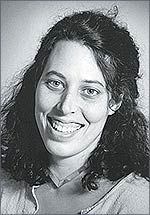


 |
 |
Issue Contents : : Alumni Notes : : Page [ 1 2 3 ]
Able Computing |
|
| Jennifer Mankoff '95 | |
Although forced to put aside her coursework for the next year, Mankoff stayed active in the department, which opened the door to a new field known as "assistive technology," or computing for the disabled. She joined a project in which the brain of a paralyzed man was implanted with a device that enabled him to manipulate a mouse. Although fraught with errors, the apparatus was considered a significant achievement. Meanwhile, Mankoff herself invented a "soft" keyboard that didn't require her to press buttons; the keyboard instead projected images of letters, which she circled with a pen. She even found a way to enjoy her music again, with the help of a 20-inch-long ergonomic viola.
Now, as assistant professor of computer science at UC-Berkeley and with the help of a Kinesis Evolution keyboard that enables her to type with both arms at her sides, Mankoff enthusiastically has taken on more projects in the field of recognition interface, such as adapting web pages to respond to tabs and returns instead of a mouse for page manipulation. Another project, inspired by her first viola teacher, who died recently of Lou Gehrig's Disease, uses word prediction software to help people confined to a wheelchair or those with motor and speech impairments to gain control over their environments.
"How to integrate technology without having it take over someone's life is the debate that many people in my field are grappling with," Mankoff says. "There is a social model of disability that says disability is defined by a person's society. Technology becomes a social problem. By helping to change technology, we're helping to change the meaning of disability."
Want more? Visit www.cs.berkeley.edu/~jmankoff/